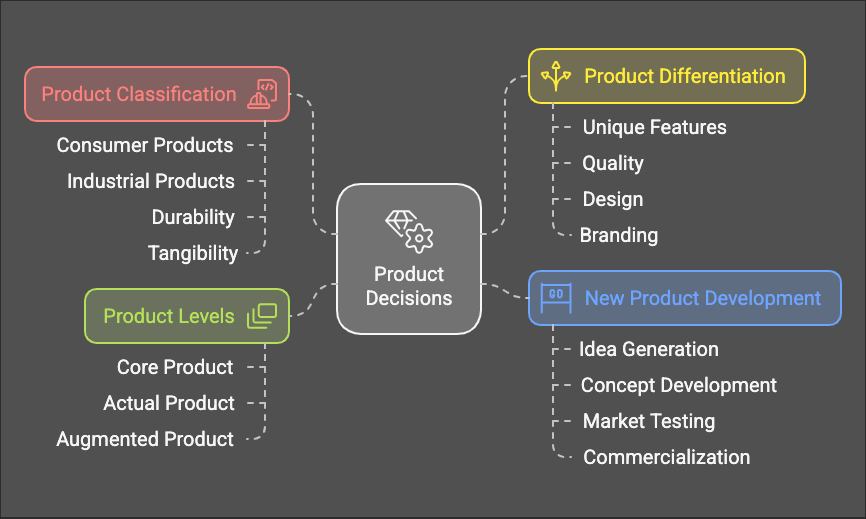Define Setting Product Strategy
Unit III: Product Decisions
This unit explores the exciting world of products and how companies make smart choices to succeed.
Setting Product Strategy
Product Classification
Products can be grouped in different ways to help businesses understand their market and make better decisions. Here are a few common classifications:
- Consumer Products: These are products bought by individuals for personal use. Think about your favorite snacks, clothes, or gadgets.
- Industrial Products: These are products used by businesses to make other products or run their operations. Examples include raw materials, machinery, and office supplies.
- Durability: Products can be durable (long-lasting, like a refrigerator) or non-durable (consumed quickly, like a chocolate bar).
- Tangibility: Products can be tangible (physical goods you can touch) or intangible (services like a haircut or a doctor's visit).
Product Levels
Think of a product like an onion – it has layers!
- Core Product: This is the basic benefit a customer gets. For a car, it's transportation. For a phone, it's communication.
- Actual Product: This is the physical product or service. It includes features, design, brand name, and packaging.
- Augmented Product: This includes extra benefits that make the product more attractive, like warranties, customer support, and delivery.
Product and Services Differentiation
In a crowded market, standing out is key. Companies differentiate their products and services by:
- Unique features: Offering something special that competitors don't have.
- Quality: Building a reputation for superior quality.
- Design: Creating an appealing and functional design.
- Branding: Building a strong brand identity that resonates with customers.
New Product Development
Stages of New Product Development
Bringing a new product to life is a journey with several stages:
- Idea Generation: Coming up with new product ideas from various sources (customers, employees, competitors, etc.).
- Idea Screening: Evaluating ideas and selecting the most promising ones.
- Concept Development and Testing: Creating a detailed concept and testing it with potential customers.
- Marketing Strategy Development: Developing a plan to market the new product.
- Business Analysis: Evaluating the financial viability of the new product.
- Product Development: Creating a prototype or a test version of the product.
- Market Testing: Introducing the product in a limited market to gather feedback.
- Commercialization: Launching the product to the full market.
Categories of New Products
- New-to-the-world products: Completely new inventions that create a whole new market.
- New product lines: Products that allow a company to enter an existing market for the first time.
- Additions to existing product lines: New products that supplement a company's existing product lines.
- Improvements and revisions of existing products: Making existing products better.
- Repositioned products: Existing products targeted at new markets or segments.
- Cost reductions: New products that provide similar performance at a lower price.
Reasons for Launching New Products
- Growth: Increase sales and market share.
- Changing customer needs: Meet evolving customer demands.
- Competition: Respond to competitors' actions.
- Technology: Take advantage of new technologies.
Reasons for New Product Failure
- Poor market research: Not understanding customer needs.
- Lack of differentiation: Failing to stand out from the competition.
- Poor marketing: Not effectively communicating the product's value.
- High costs: Pricing the product too high or having high development costs.
- Technical problems: Product defects or design flaws.

